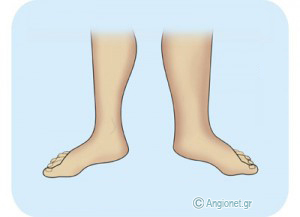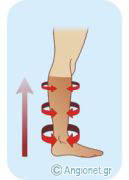- What is lymphoedema?
- What causes lymphoedema?
- What are the symptoms of leg lymphoedema?
- What consequences may lymphoedema have?
- Are there any other causes of lymphoedema?
- How is lymphoedema diagnosed?
- What does the treatment involve?
- How about surgery?
- How can I prevent my lymphoedema getting worse?
What is lymphoedema?
Lymphoedema is a condition which causes swelling (or “oedema”) of a limb. This usually affects the lower limbs.
Apart from the blood vessels, i.e. the arteries which bring the blood from the heart to the tissues and the veins which return it to the heart, in our body there is another kind of vessels, the lymph vessels, which are part of the lymphatic system. The lymphatic system consists of all lymph vessels and lymph nodes that run through the body. Lymph vessels collect a fluid (called the lymph) that is made up of protein, water, salts, fats, and wastes from the cells of the body, and carry it to the lymph nodes. Lymph nodes filter waste materials and foreign products, and then return the lymph fluid to the blood.
If your lymphatics (lymph vessels and nodes) are not well developed or get damaged, the lymph fluid cannot move freely through the system. The excess fluid can then build up in the limb and cause the swelling.
What causes lymphoedema?
The most common cause of lymphoedema is that you were born without enough lymphatics. This type of lymphoedema is the primary lymphoedema. Women are affected three times more often than men, and the left leg more often than the right, while upper limbs are rarely affected. One leg is often worse than the other and sometimes only one leg is affected.
If there are very few lymphatics, the swelling may start as a teenager or even earlier. In less severe cases, the lymphatics may cope for some years and only start to fail when you are older. If the swelling appears before the age of 35 years, the lymphoedema is called early (or praecox) and is commoner, while if it appears after 35, it is called late (or tarda).
What are the symptoms of leg lymphoedema?
 The swelling may affect the foot, toes, ankles, lower part of the leg or the whole leg.
The swelling may affect the foot, toes, ankles, lower part of the leg or the whole leg.
Initially, the swelling appears only by the end of the day and disappears with bed rest at night. However, if it isn’t kept under control, the fluid may settle permanently in the limb causing an increase in the fat mass and tissue hardening, called fibrosis.
The skin gets dry, thick and hard, and hyperkeratosis and papillomatosis may occur, but skin changes like dermatitis are uncommon (unless venous stasis co-exists).
A practical way to classify the clinical impact of lymphoedema, from mild to severe, is the following staging:
- Stage 0 – This means that swelling is not yet visible, although there is damage to the lymphatic system of the limb. This stage may exist months or even years before swelling occurs
- Stage Ι – This means that the skin indents when it is pressed. This occurs as long as the degree of scarring (ie, development of fibrous tissue) is still minimal. Elevating the affected limb often helps reduce the swelling (“spontaneously reversible stage”)
- Stage ΙΙ – This means that the skin does not indent when it is pressed. This occurs because there is moderate to severe scarring. Elevating the affected limb does not help the swelling (“spontaneously irreversible stage”)
- Stage ΙΙΙ – This means that there is extensive scarring with hardening of the skin and the subcutaneous fat. The affected limb is significantly swollen and the skin texture has changed. This is a permanent condition
Sometimes, symptoms occur and include aching, heaviness or tightness in the limb.
Lymphoedema of a limb tends to get worse when the weather is warm, after prolonged use of the limb or before menstruation.
What consequences may lymphoedema have?
Apart from the unsightly appearance due to the swelling, lymphoedema may cause problems, especially if not kept under control.
Without treatment the skin gradually gets thick and small blisters (hyperkeratosis and papillomatosis) may appear. Even a minor injury to the skin, such as a cut, scratch, insect bite, or even athlete’s foot between the toes, can cause a severe infection. The infection under the skin is called cellulitis. Repeated attacks of cellulitis may cause further damage to the lymphatics. Any injury must be taken seriously.
In leg lymphoedema, occurrence of leg ulcers is rare, but possible.
Are there any other causes of lymphoedema?
Lymphoedema may occur if the lymphatics of an arm or leg are damaged by surgery, trauma, arthritis (like rheumatoid and psoriasic), cancerous infiltration, radiation therapy for cancer, insect or snake bite.
Also, lymphoedema may result from an acute infection in a limb. In this case, lymphedema presentation is abrupt and accompanied by high fever and rigors. The limb is swollen, red and warm, while there may be red lines on the skin (lymphangiitis) and the regional lymph nodes may be swollen and tender.
There are some rare tropical parasites which affect and block lymphatics (filariasis). These parasites do not live in Europe.
The above types of lymphoedema are called secondary lymphoedema.
How is lymphoedema diagnosed?
The diagnosis of lymphoedema is usually based on history and physical examination alone. However, in some cases certain investigations may be required to rule out other causes of the swelling. Chronic venous insufficiency can be ruled out by duplex ultrasonography of the leg veins. The presence of a mass in the abdomen compressing veins or lymphatics may be ruled out by ultrasonography or CT scanning.
The investigation done to confirm the diagnosis of lymphoedema is lymphoscintigraphy or radionuclide lymphangiography (a scan of the lymphatics). A low dose radioactive substance is injected between toes in both feet and allowed to flow in the lymph fluid. Pictures of both legs are taken by gamma-camera at intervals to assess the spead of lymph flow through the lymphatic system of the limbs, and any delay is clearly demonstrated. This test does not, however, show what type of abnormality is present, for example, too few lymphatics or a normal number of poorly functioning ones, but often this does not alter the management. Although highly accurate, in most cases this test is reduntant, since diagnosis has been made clinically.
What does the treatment involve?
Lymphoedema is a chronic problem. There are no conservative or surgical means to cure the affected limb. However, it is extremely important to keep it under control with suitable therapeutic measures in order that no complications occur in the future.
The main goal of lymphoedema management is swelling control. The treatment of lymphoedema involves two phases:
- the phase of reduction (or decongestion), which mainly includes manual lymphatic drainage (massage to stimulate the lymphatic system) and elastic compression with lymphologic bandages. When edema has been reduced by 70-80%, measures are taken for the “compression garment”
- the phase of maintenance and improvement, which in general includes limb elevation and use of the “compression garment” (ie, compression stockings if the oedema affects a leg). Daily use of the stockings is required. In this phase, use of external pneumatic compression (EPC) may have a role
At times, the two phases of lymphoedema therapy may interchange. Diuretics are of very limited help in lymphoedema nad rather contraindicated.
– Elevation of the limb and regular exercise – Whenever the leg is elevated, fluid will tend to drain out of it. Put your legs up when you can. Elevate the end of your bed (around 15 cm), so that your feet are a little higher than the heart. Regular exercise, like walking or cycling, will also be beneficial.
– Compression with bandages or graduated compression stockings – Compression is required to squeeze the fluid out of your legs when you are standing up.
 For lymphoedema of relatively mild degree, i.e. when the swelling goes almost completely down with bed rest (Stage I), use of stockings may be an adequate therapeutic measure.
For lymphoedema of relatively mild degree, i.e. when the swelling goes almost completely down with bed rest (Stage I), use of stockings may be an adequate therapeutic measure.
These stockings need to be specially fitted and are much stronger than ordinary “support tights”. If the swelling only affects the lower leg, you can use a below-knee stocking. We usually recommend class 2 (25-35 mmHg) or class 3 (35-45 mmHg) stockings, but occasionally the highest compression class 4 (45-60 mmHg) may be required.
If you try to put on your stockings while the leg is very swollen, they will not fit well, therefore, it is important to have previously reduced the swelling with another method before stockings can be used; suitable methods may be manual lymphatic massage, bandaging and elevation, while use of EPC may also help.
– Manual lymphatic drainage, or MLD (or lymphatic massage) – The lymphoedematous limb, in general, may benefit from the technique of tissue massaging (with mild, circular, relatively superficial movements, without oil use) to activate healthy lymhatics provided that it is performed by a suitably trained and qualified therapist. Manual lymphatic drainage is nowadays considered an indispensable part of integrate lymphoedema management. It is delivered in sessions of 30-45 min duration each followed by compression bandaging.
This treatment is not indicated if there is acute inflammation (cellulitis), a malignant tumor, thrombosis or a major heart problem.
– Use of a pump for external pneumatic compression (EPC) – Despite the use of compression stockings some people find that some swelling accumulates by the end of the day. Use of compression pumps was one of the main methods used in reduction therapy of lymphoedema before manual lymphatic drainage became popular.
 The EPC device (such as Flowtron®, LymphaPress®, Vasoflow® etc) is a boot that inflates and deflates with air delivering compression in a sequential manner and milking fluid out of the leg. Normally, EPC is used in the evening to get rid of the fluid that has built up despite stocking use.
The EPC device (such as Flowtron®, LymphaPress®, Vasoflow® etc) is a boot that inflates and deflates with air delivering compression in a sequential manner and milking fluid out of the leg. Normally, EPC is used in the evening to get rid of the fluid that has built up despite stocking use.
If your doctor believes you need this type of therapy, arrange a trial of the device before you decide whether it is worth buying one.
How about surgery?
The surgical treatment of lymphoedema is reserved for very severe cases. Nearly all the surgical procedures are associated with quite extensive scarring and surgery is not generally recommended for mild to moderate lymphoedema.
Certain patients with advanced lymphoedema who do not respond well to conservative management may have long-term benefits by a newer procedure called circumferential suction-assisted lipectomy (CSAL).
How can I prevent my lymphoedema getting worse?
If you suffer from leg lymphoedema, it is vital to look after your leg and foot very carefully.
- Daily care of the skin is required, mainly between the toes to prevent infections, including athletes’ foot. It is essential that any infection is treated early because it can cause further damage to the lymphatics and make the swelling worse. If you get recurrent skin infections, you may need to take low-dose antibiotic therapy for a long period
- Avoid cuts, scratches, insect bites, sprains, burns etc. Any injury must be taken seriously
- Maintain your ideal body weight
- Take regular exercise, avoiding standing or sitting for long periods of time
- Never forget your compression stocking
EXTERNAL LINKS
- LYMPHEDEMA DIAGNOSIS AND THERAPY (Chapter 20) The Layman’s Handbook of Venous Disorders (pages 96-101 out of 101)
- FOELDI CLINIC: Specialist clinic for Lymphology in Germany https://www.foeldiklinik.de/home-en-gb/
- LYMPHEDEMA: Management and Complete Physical Decongestive Therapy: a manual for treatment, Pritschow H and Schuchhardt C (eds)
Last modified 06/06/2018






